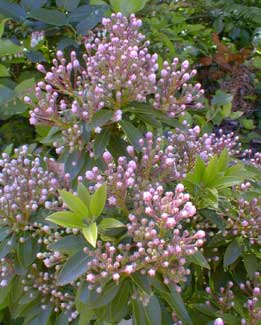
'Elf' Mountain Laurel; or,
Dwarf Myrtle-leafed Kalmia
"Down many a shelving ledge of shale,
skirting the trembling sands,
Through many a pool & many a pass,
where the mountain laurel stands."
-William Aspinwall Bradley
(1878-1939)
(1878-1939)
Kalmia latifolia forma myrtilfolia is a natural dwarf form, synonymous with K. latifolia variant nana, variant laevipes, or variant minor.
Several compact garden cultivars have been developed from this form, each one half or one-third the size of the species, including leaves half the size of the species for a true miniature. The variety 'Elf' was bred by Dr. Richard Jaynes of Connecticut.
It is shown here in full pink bud in May. The buds open into white cups only slightly smaller than flowers for the full sized species, even though the leaves are half the size of the species. Spent flowers should be removed quickly, for to leave them on the bush retards flowering the following year.
This native of northeastern North America is strongly evergreen, mature at two or two & a half feet of height. Over time it will very slowly spread four to five feet while remaining very short.
'Elf' kalmia is good for zones 5 through 8, & possibly in Zone 4 with protection. It wants loamy acidic soil, moist but well-draining, in partial to bright shade. It can be treated like & grown among rhododendrons. It likes to be planted with its rootball's top a bit higher than the surrounding soil to maximize drainage.
If there is any chance that the sun might heat the roots, they should be mulched with a pale mulch to keep them cool. Kalmia will not thrive in areas with naturally alkaline soil or where summers are very hot. And where the soil is clayey they will require raised beds to be assured of the essential drainage.
When its requirements are met it is a fairly low-maintenance shrub very easy to grow, though in conditions not to its liking it will not be attractive or rewarding.
The plant is rich in grayanotoxins sufficient to be harmful to browsing livestock. Grayanotoxins not only repel deer & elk from foraging, but are natural insecticide so that the shrub is rarely troubled by pests.